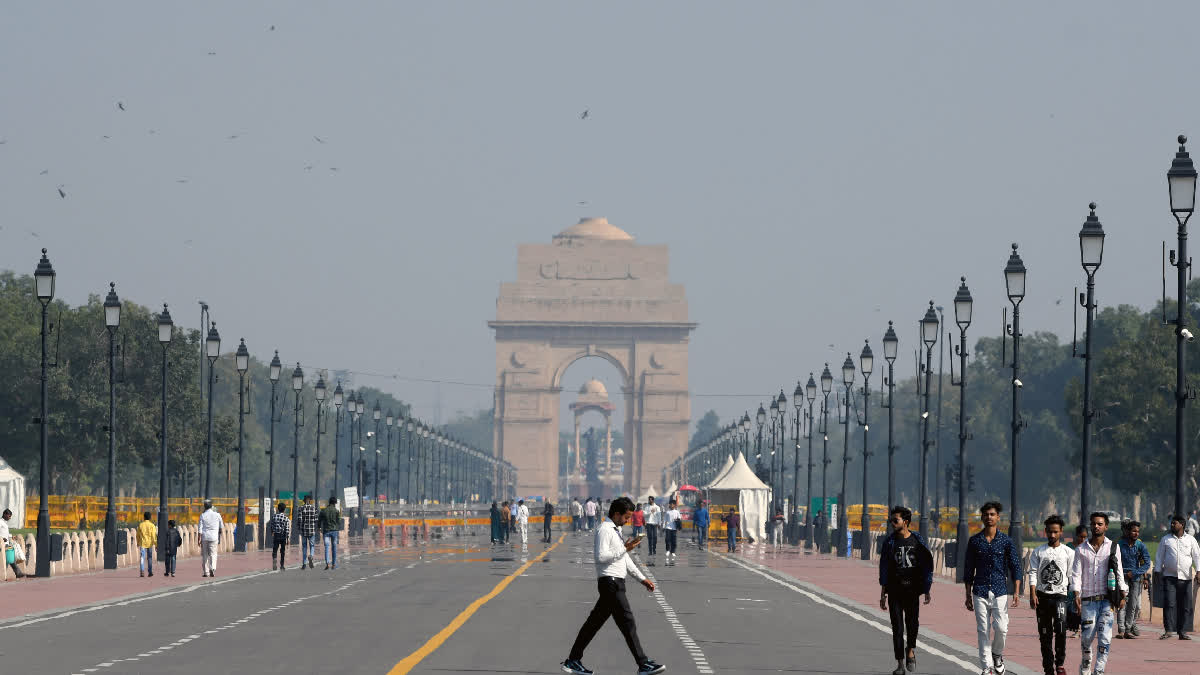New Delhi: For the second consecutive day, Delhi residents rejoiced under clear blue skies as the city's air quality continued to improve, settling in the 'moderate' zone on Friday. On Thursday, the Air Quality Index (AQI) was recorded at 165 by the Central Pollution Control Board (CPCB), offering much-needed respite after weeks of toxic air.
Residents across the city expressed their delight at the improved conditions. Ramesh Sahu, a shopkeeper in Connaught Place, said, "It feels great to finally breathe fresh air. The blue skies remind me of the Delhi I grew up in. I hope the authorities can maintain this momentum."
Similarly, Sonal Sharma, a school teacher, remarked, “Our students can finally return to physical classes without the constant fear of pollution-related health issues. It’s a big relief for parents and teachers alike.”
This improvement, driven by strong winds and bright sunshine, prompted the Commission for Air Quality Management (CAQM) to relax Stage 4 measures of the Graded Response Action Plan (GRAP). These restrictions had been enforced to tackle severe pollution levels in Delhi-NCR.
Supreme Court directive
The CAQM’s decision followed a directive from the Supreme Court, which permitted the implementation of GRAP-2 measures in place of GRAP-4. A bench led by Justice Abhay Oka emphasized that stricter measures must be reinstated if pollution levels surge.
The court mandated that GRAP-3 be implemented if AQI levels exceed 350 and GRAP-4 be reintroduced if levels cross 400. It also directed the CAQM to maintain Stage 2 restrictions at a minimum, incorporating some GRAP-3 measures until the AQI shows sustained improvement.
Key relaxations and current measures
The relaxation of GRAP-4 measures means a significant shift in daily life for Delhi residents and industries:
• Diesel Vehicle Ban Lifted: Diesel-run medium and heavy vehicles (BS-IV or below) registered in Delhi can now enter the city, barring those carrying non-essential goods.
• School Resumption: The Directorate of Education announced that all government, government-aided, and private schools in Delhi are to resume physical classes immediately.
• Construction and Industry: Sites previously shut for non-compliance with anti-pollution norms will remain closed unless specifically authorized by the CAQM.
Despite these relaxations, citizens are urged to adhere to pollution mitigation guidelines, particularly during the winter months when air quality often deteriorates rapidly.
A welcome respite
Delhi’s battle against pollution has been arduous. The capital’s air quality entered the “very poor” category on October 30 and remained consistently above 300 AQI for over two weeks in November. The situation worsened, with AQI levels exceeding 400, placing it in the “severe” zone.
The tide began to turn in early December, as strong winds and improved weather conditions dispersed pollutants. On December 1, the AQI improved to the “poor” category, gradually advancing to the “moderate” zone by mid-week.
The last time Delhi experienced an AQI of this level was on October 12, with a reading of 155. Thursday’s AQI of 165 marked the cleanest December air in two years, surpassing the previous best of 163 on December 14, 2022.
Challenges ahead
While the improvement is a welcome change, experts warn that the reprieve may be temporary. A drop in minimum temperatures and reduced wind speeds over the weekend are expected to bring pollution levels back into the “poor” or “very poor” categories. The Centre’s Early Warning System (EWS) for Delhi predicts a return to worsening air quality in the coming week.
Historical data supports this caution. In December 2022, the average AQI was 348, with three “severe” air quality days. The second half of December typically sees pollution spikes due to plummeting temperatures, stagnant air, and dense fog, which trap pollutants closer to the ground.
Addressing Construction Workers’ Welfare
The Supreme Court also addressed concerns about the welfare of construction workers affected by the pollution-related bans. The Delhi government reported that Rs 2,000 had been paid to 90,693 registered workers as subsistence, with an additional Rs 4,000 promised.
However, the court criticized the government for failing to reach unregistered workers. Similar instructions were issued to other NCR states, including Haryana, Uttar Pradesh, and Rajasthan, emphasizing the need for equitable support for affected workers.
While the current improvement offers hope, Delhi’s air quality remains a fragile issue requiring sustained and coordinated efforts. The relaxation of GRAP-4 measures signifies progress, but authorities and residents must stay vigilant as winter conditions threaten to reverse recent gains.
The coming weeks will be crucial in determining whether Delhi can maintain this cleaner air or succumb once more to the seasonal scourge of pollution.



